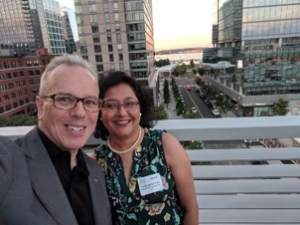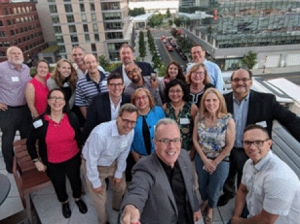L-R: Parna Sarkar-Basu of Brand & Buzz Marketing, Stephen Pappas of Panviva, Claritza N. Abreu of StateStreet, Jaime Punishill of Lionbridge and Larry Kim of MobileMonkey.
How Bots Are Transforming Customer Engagement – AMA Boston Event Recap
One of the most interesting and challenging topic today is the role of technology in customer engagement – a topic that was explored at AMA Boston’s Thursday, June 21 event. A team of experienced tech executives covered the fascinating opportunities and issues related to chatbots, including current trends, success stories, concerns, and predictions of future applications. We also discussed if robots will replace humans.
The panelists were Steve Pappas, head of North American Operation, Sr. V.P. and global CMO of Panviva; Jaime Punishill, Chief Marketing Officer, Lionbridge; Claritza N. Abreu, vice president, State Street Corporation; and Larry Kim, CEO of MobileMonkey and founder of WordStream.
 The event was kicked off by incoming AMA Boston President Bob Cargill, followed by a brief word from our gracious hosts, Maggie Bergman and Jordyn Buglione from Industrious Boston — an innovative coworking company that opened their beautiful space in the Seaport district.
The event was kicked off by incoming AMA Boston President Bob Cargill, followed by a brief word from our gracious hosts, Maggie Bergman and Jordyn Buglione from Industrious Boston — an innovative coworking company that opened their beautiful space in the Seaport district.
Moderator Parna Sarkar-Basu, CEO of Brand and Buzz Marketing and AMA Boston board member, opened the session by providing the following comments to help set the stage.
“Customer experience can make or break a company. Power has shifted away from companies to customers. In fact, customer experience is the new BRAND. The new Competitive EDGE.”
According to analyst firm Gartner, 89 percent of companies expect to compete on the basis of customer experience in the next two years and 47 percent of organizations will use chatbots for customer care and 40 percent will deploy virtual assistants, Parna added.
She then asked the panelist to share their expertise and passion with the audience and then they took us into the world where business strategy, technology, artificial intelligence (AI), and customer engagement interact.
Rather than rely on formal presentations, Parna directed questions to a panelist and the ensuing discussion usually evolved to include observations from the others. This led to a free-flowing conversation, ending with a very lively Q + A that included insightful questions and input from the audience.
Here are some of the primary takeaways:
- There are many related entities in the broader view of this topic, all revolving around the concept of computer program designed to simulate conversation with human users. Chatbots, chatblasts, IVRs (interactive voice response devices) and similar services are growing and morphing rapidly, building on pioneering services such as GotoMeeting and teleconferencing.
- Chatblasts such as What’s App involve reaching out to defined groups or communities, per Claritza.
- Claritza also mentioned how mobile apps allow communities to connect and generate personal engagement.
- Technology solutions are often rushed and the customer needs are still unclear, hence promising tools like Google Glass falter initially.
- Stephen described the “silo problem,” in which there is not fast enough interaction between bots and people to satisfy the customer.
- He also noted that a single data repository is required to meet the unique needs of each customer, both for timely response and to deliver on the “customer promise.”
- Stephen sees bots in customer service as crucial to more higher-level customer care, e.g. “my credit card was lost.” The transformation to bots and humans living together is underway.
- Jaime indicated that “training your systems to interact is very challenging and time consuming and “chatBots are just the latest tool people will struggle with.” Most everyone agreed that training the bots or related systems is crucial but difficult.
- There was much conversation about “use cases,” which helped clarify the definition of the chatbots and blasts and their application. In the case of a text alert for a doctor’s appointment, the initial steps are clear but the machine can’t manage the interaction if it’s not clear-cut. Claritza agreed, saying “starting is easy; closing the deal is hard.” Larry’s position was echoed by others: “narrow use cases are most likely to succeed.”
- Larry reported that chatblasts are “more than spam” and can create news experiences, in part because they are very strict on opt-in.
 A discussion around the current capabilities of bots and blasts was a topic of lively discussion. Larry felt they are best for “top of the funnel” such as lead generation, as FAQs proved too complex.
A discussion around the current capabilities of bots and blasts was a topic of lively discussion. Larry felt they are best for “top of the funnel” such as lead generation, as FAQs proved too complex.- Jaime noted that neural networks are integral to recent leaps in these new technologies.
- There is tremendous convergence around the use of voice in customer strategy, with Google Home, Alexa and Siri battling while other virtual assistants and IVRs evolve.
- Strategy is still the heart of exceptional customer service; virtual assistants are not a solution until it’s clear what customer problem is being solved, and what process and content best address it.
- Parna shared a stat that showed 73% of people are not coming back after a bad experience with chatbots indicates the need for strategic thinking and testing prior to putting bots in a key service function.
- Retail and hospitality currently lead the pack in this new are, especially retail ecommerce; health care is using notifications effectively but still constrained by tight regulations; telecom is making progress too. While Stephen agreed with an audience member that the use of technology and customer experience is being driven by B2C now, Larry disagreed, pointing out that people are still making these decisions.
In sum, this terrific event affirmed the importance of technology in customer experience and engagement, which is becoming a leading point of differentiation. While chatbots and similar services will not replace humans anytime soon, they are becoming a force in customer service. These innovations will help companies deliver more value as long as the implementations start with strategy, data, and effective processes rather than flashy technology.
 Parna wrapped up the conversation with: “Humans, especially marketers, will still be needed, even in the age of robots.” AMA Boston would like to thank our experts, Industrious Boston, and the audience for their active participation.
Parna wrapped up the conversation with: “Humans, especially marketers, will still be needed, even in the age of robots.” AMA Boston would like to thank our experts, Industrious Boston, and the audience for their active participation.
We hope to see you at our next Marketing Mingle on July 12.
Photos: Courtesy of Bob Cargill.


